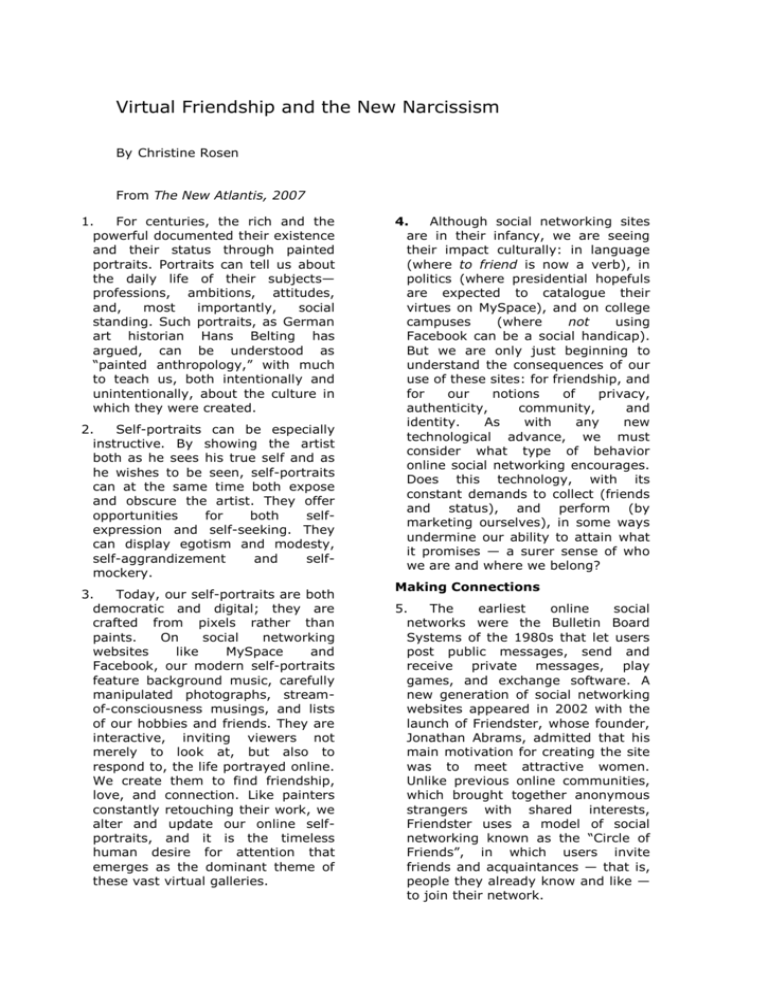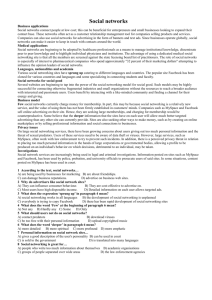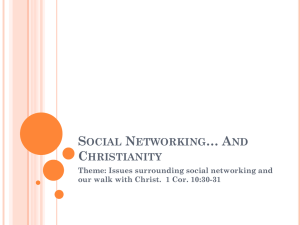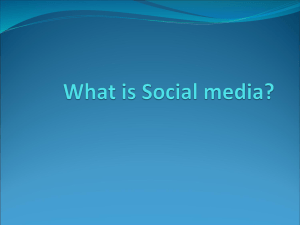Virtual Friendship and the New Narcissism By Christine Rosen From
advertisement

Virtual Friendship and the New Narcissism By Christine Rosen From The New Atlantis, 2007 1. For centuries, the rich and the powerful documented their existence and their status through painted portraits. Portraits can tell us about the daily life of their subjects— professions, ambitions, attitudes, and, most importantly, social standing. Such portraits, as German art historian Hans Belting has argued, can be understood as “painted anthropology,” with much to teach us, both intentionally and unintentionally, about the culture in which they were created. 2. Self-portraits can be especially instructive. By showing the artist both as he sees his true self and as he wishes to be seen, self-portraits can at the same time both expose and obscure the artist. They offer opportunities for both selfexpression and self-seeking. They can display egotism and modesty, self-aggrandizement and selfmockery. 3. Today, our self-portraits are both democratic and digital; they are crafted from pixels rather than paints. On social networking websites like MySpace and Facebook, our modern self-portraits feature background music, carefully manipulated photographs, streamof-consciousness musings, and lists of our hobbies and friends. They are interactive, inviting viewers not merely to look at, but also to respond to, the life portrayed online. We create them to find friendship, love, and connection. Like painters constantly retouching their work, we alter and update our online selfportraits, and it is the timeless human desire for attention that emerges as the dominant theme of these vast virtual galleries. 4. Although social networking sites are in their infancy, we are seeing their impact culturally: in language (where to friend is now a verb), in politics (where presidential hopefuls are expected to catalogue their virtues on MySpace), and on college campuses (where not using Facebook can be a social handicap). But we are only just beginning to understand the consequences of our use of these sites: for friendship, and for our notions of privacy, authenticity, community, and identity. As with any new technological advance, we must consider what type of behavior online social networking encourages. Does this technology, with its constant demands to collect (friends and status), and perform (by marketing ourselves), in some ways undermine our ability to attain what it promises — a surer sense of who we are and where we belong? Making Connections 5. The earliest online social networks were the Bulletin Board Systems of the 1980s that let users post public messages, send and receive private messages, play games, and exchange software. A new generation of social networking websites appeared in 2002 with the launch of Friendster, whose founder, Jonathan Abrams, admitted that his main motivation for creating the site was to meet attractive women. Unlike previous online communities, which brought together anonymous strangers with shared interests, Friendster uses a model of social networking known as the “Circle of Friends”, in which users invite friends and acquaintances — that is, people they already know and like — to join their network. 6. Friendster was an immediate success, with millions of registered users by mid-2003. But technological problems and poor management at the company allowed a new social networking site, MySpace, launched in 2003, quickly to surpass it. Originally started by musicians, MySpace has become a major venue for sharing music as well as videos and photos. It is now the monster of online social networking, with over 100 million registered users. Connection has become big business: In 2005, Rupert Murdoch’s News Corporation bought MySpace for $580 million. 7. Besides MySpace and Friendster, the best-known social networking site is Facebook, launched in 2004. Originally restricted to college students, Facebook — which takes its name from the small photo albums that colleges once gave to incoming freshmen and faculty to help them cope with meeting so many new people — soon extended membership to high schoolers and is now open to anyone. Still, it is most popular among college students and recent college graduates, many of whom use the site as their primary method of communicating with one another. Millions of college students check their Facebook pages several times every day and spend hours sending and receiving messages, making appointments, getting updates on their friends’ activities, and learning about people they might recently have met or heard about. 8. There are dozens of other social networking sites, including Orkut, Bebo, and Yahoo 360º. There are professional networking sites, such as LinkedIn, that keep people connected with present and former colleagues and other business acquaintances. There are sites specifically for younger children, such as Club Penguin, which lets kids pretend to be cute colored penguins who waddle around chatting, playing games, earning virtual money, and buying virtual clothes. For people who want to join a social network but don’t know which site is right for them, there are sites that help users locate the proper online social networking community for their particular interests. 9. Social networking sites are also fertile ground for those who make it their lives’ work to get your attention — namely, spammers, marketers, and politicians. Incidents of spamming and spyware on MySpace and other social networking sites are endless. Legitimate advertisers such as record labels and film studios have also set up pages for their products. A marketing officer for the giant company Proctor and Gamble recently told the Wall Street Journal that from a business perspective, social networking sites are “going to be one giant living dynamic learning experience about consumers.” 10. As for politicians, with the presidential primary season now underway, candidates have embraced social networking. Senator Hillary Clinton has official pages on social networking sites MySpace, Flickr, LiveJournal, Facebook, Friendster, and Orkut. As of July 1, 2007, she had a mere 52,472 friends on MySpace; her Democratic rival Senator Barack Obama had an impressive 128,859. Degrees of Separation 11. It is worth pausing for a moment to reflect on the curious use of the word networking to describe this new form of human interaction. Social networking websites “connect” users with a network — literally, a computer network. But the verb to network has long been used to describe an act of intentional social connecting, especially for professionals seeking careerboosting contacts. When the word first came into circulation in the 1970s, computer networks were rare and mysterious. Back then, “network” usually referred to television. But social scientists were already using the notion of networks to map out human relations and calculate just how closely we are connected. 12. In 1967, Harvard sociologist and psychologist Stanley Milgram, best known for his earlier Yale experiments on obedience to authority, published the results of a study about social connection that he called the “small world experiment.” “Given any two people in the world, person X and person Z,” he asked, “how many intermediate acquaintance links are needed before X and Z are connected?” Milgram’s research, which involved sending out a kind of chain letter and tracing its journey to a particular target person, yielded an average number of 5.5 connections. The idea that we are all connected by “six degrees of separation” is now generally accepted. 13. But is it true? Duncan J. Watts, a professor at Columbia University and author of Six Degrees: The Science of a Connected Age, has embarked on a new small world project to test Milgram’s theory. Similar in spirit to Milgram’s work, it relies on e-mail to determine whether “any two people in the world can be connected via ‘six degrees of separation.’” Unlike Milgram’s experiment, which was restricted to the United States, Watts’s project is global; as he and his colleagues reported in the respected journal Science, “Targets included a professor at an Ivy League university, an archival inspector in Estonia, a technology consultant in India, a policeman in Australia, and a veterinarian in the Norwegian army.” Their early results suggest that Milgram might have been right: messages reached their targets in five to seven steps, or links, on average. 14. What kind of “links” are these? In a 1973 essay, “The Strength of Weak Ties,” sociologist Mark Granovetter argued that weaker relationships, such as those we form with colleagues at work or minor acquaintances, were more useful in spreading certain kinds of information than networks of close friends and family. Watts found a similar phenomenon in his online small world experiment: weak ties (largely professional ones) were more useful than strong ties for locating far-away individuals, for example. 15. Today’s online social networks are collections of mostly weak ties — no one who lists thousands of “friends” on MySpace thinks of those people in the same way as he does his flesh-and-blood acquaintances, for example. It is surely no coincidence, then, that the activities social networking sites promote are precisely the ones weak ties foster, like gossip, finding people, and tracking the ever-shifting movements of popular culture and fads. If this is our small world, it is one that gives its greatest attention to small things. Won’t You Be My Digital Neighbor? 16. According to a survey recently conducted by the Pew Internet and American Life Project, more than half of all Americans between the ages of twelve and seventeen use some online social networking site. Indeed, media coverage of social networking sites usually describes them as vast teenage playgrounds. At the heart of this scenario is a deep generation gap, with tech-smart youngsters redefining friendship while their ignorant elders look on with bafflement and increasing anxiety. 17. Enthusiasts of social networking argue that these sites are not merely entertaining; they also educate by teaching users about the rules of social space. As Danah Boyd, a graduate student studying social networks at the University of California, Berkeley, told the authors of MySpace Unraveled, social networking promotes “informal learning.... It’s where you learn social norms, rules, how to interact with others, personal and group history, and media literacy.” This is more a hopeful assertion than a proven fact, however. The question that isn’t asked is how the technology itself affects that process of informal learning. All communities expect their members to internalize certain norms: for example, patrons of libraries are expected to keep noise to a minimum. New technologies are challenging such norms — cell phones ring during movies; loud televisions in doctors’ waiting rooms make it difficult to talk quietly — and new norms must develop to replace the old. What cues are young social networkers learning about social space? What unspoken rules and communal norms have the millions of participants in these online social networks internalized, and how have these new norms influenced their behavior in the offline world? Self-exposure 18. There is one norm of online social networking that is found everywhere: its users are committed to self-exposure. The creation and consumption of intimate details and images of one’s own and others’ lives is the main activity in the online social networking world. There is no room for privacy; there is only revelation. Quickly read a profile and you know more about a potential acquaintance in a moment than you might have learned about a flesh-and-blood friend in a month. 19. Social networkers, particularly younger users, are often naïve or illinformed about the amount of information they are making publicly available. “One cannot help but be amazed at the amount, detail, and nature of the personal information some users provide,” Carnegie Mellon researchers Alessandro Acquisti and Ralph Gross wrote in 2006. In a survey of Facebook users at their university, Acquisti and Gross “detected little or no relationship between participants’ reported privacy attitudes and their likelihood of publishing personal information online". Even among the students in the survey who claimed to be most concerned about their privacy — the ones who worried about “the scenario in which a stranger knew their schedule of classes and where they lived” — about 40 percent provided their class schedule on Facebook, about 22 percent put their address on Facebook, and almost 16 percent published both. 20. This kind of carelessness has provided food for many sensationalist news stories. To cite just one: In 2006, NBC’s Dateline featured a police officer posing as a 19-year-old boy who was new in town. Although not connected to any particular local community, the imposter quickly gathered more than 100 friends for his MySpace profile and began corresponding with several teenage girls. Although the girls claimed to be careful about the kind of information they posted online, when Dateline revealed that their new friend was actually an adult male who had figured out their names and where they lived, they were surprised. The danger posed by strangers who use social networking sites to prey on children is real; there have been several such cases. This danger was highlighted in July 2007 when MySpace booted from its system 29,000 sex offenders who had signed up for memberships using their real names. There is no way of knowing how many sex offenders have MySpace accounts registered under fake names. 21. There are also professional risks to putting too much information on social networking sites, just as for several years there have been career risks associated with personal homepages and blogs. A survey conducted in 2006 by researchers at the University of Dayton found that “40 percent of employers say they would consider the Facebook profile of a potential employee as part of their hiring decision, and several reported withdrawing offers after checking out Facebook.” Yet college students’ reaction to this fact suggests that they have a different understanding of privacy than potential employers: 42 percent thought it was a violation of privacy for employers to read their profiles, and “64 percent of students said employers should not consider Facebook profiles during the hiring process.” revelation of intimate details over time and within specific social (and cultural) contexts. Because friendship depends on mutual revelations that are concealed from the rest of the world, it can only flourish within the boundaries of privacy; the idea of public friendship is an oxymoron1. 22. This is a quaintly Victorian notion of privacy, embracing the idea that individuals should be able to compartmentalize and parcel out parts of their personalities in different settings. It suggests that even behavior of a decidedly questionable or hypocritical bent (the Victorian patriarch who also cavorts with prostitutes, for example, or the straight-A business major who posts picture of himself funneling beer on his MySpace page) should be tolerated if appropriately segregated. But when one’s darker side finds expression in a virtual space, privacy becomes more difficult and true compartmentalization nearly impossible; on the Internet, private misbehavior becomes public exhibitionism. 25. The hypertext link called “friendship” on social networking sites is very different: public, fluid, and promiscuous, yet oddly bureaucratized. Friendship on these sites focuses a great deal on collecting, managing, and ranking the people you know. Everything about MySpace, for example, is designed to encourage users to gather as many friends as possible, as though friendships were stamps. If you are so unfortunate as to have but one MySpace friend, for example, your page reads: “You have 1 friends,” along with a stretch of sad empty space where dozens of thumbnail photos of your acquaintances should appear. The New Taxonomy of Friendship 23. There is a Spanish proverb that warns, “Life without a friend is death without a witness.” In the world of online social networking, the warning might be simpler: “Life without hundreds of online ‘friends’ is virtual death.” On these sites, friendship is the stated purpose. “A place for friends,” is the slogan of MySpace. Facebook is a “social utility that connects people with friends.” Orkut describes itself as “an online community that connects people through a network of trusted friends.” Friendster’s name speaks for itself. 24. But “friendship” in these virtual spaces is thoroughly different from real-world friendship. In its traditional sense, friendship is a relationship which, broadly speaking, involves the sharing of mutual interests, reciprocity, trust, and the 26. This promotes a form of frantic friend collection. As one young Facebook user with 800 friends told John Cassidy in The New Yorker, “I always find the competitive spirit in me wanting to increase the number.” An associate dean at Purdue University recently boasted to the Christian Science Monitor that since establishing a Facebook profile, he had collected more than 700 friends. The phrase universally found on MySpace is, “Thanks for the add!”— an acknowledgment by one user that another has added you to his list of friends. 27. The structure of social networking sites also encourages the bureaucratization of friendship. Each site has its own terminology, but among the words that users employ most often is “managing.” The Pew survey mentioned earlier found that “teens say social networking sites 1 כגון "שתיקה,ביטוי המכיל צירוף ניגודים )"רועמת help them manage their friendships.” There is something Orwellian2 about the managementspeak on social networking sites: “Change My Top Friends,” “View All of My Friends” and, for those times when our inner Stalins sense the need for a virtual purge, “Edit Friends.” With a few mouse clicks one can elevate or downgrade (or entirely eliminate) a relationship. 28. To be sure, we all rank our friends, albeit in unspoken and intuitive ways. One friend might be a good companion for outings to movies or concerts; another might be someone with whom you socialize in professional settings; another might be the kind of person for whom you would drop everything if he needed help. But social networking sites allow us to rank our friends publicly. And not only can we publicize our own preferences in people, but we can also examine the favorites among our other acquaintances. We can learn all about the friends of our friends — often without having ever met them in person. Beyond Networking 29. In spring 2007, Len Harmon, the director of the Fischer Policy and Cultural Institute at Nichols College in Dudley, Massachusetts, offered a new course about social networking. Nichols is a small college whose students come largely from Connecticut and Massachusetts; many of them are the first members of their families to attend college. “I noticed a lot of issues involved with social networking sites,” Harmon told me when I asked him why he created the class. How have these sites been useful to Nichols students? “It has relieved some of the stress of transitions for them,” " על1984" התייחסות לג'ורג' אורוול וספרו2 , ועל מעמדו של היחיד,המשטר הקומוניסטי .זכויותיו ויחסיו החברתיים בתוכו he said. “When abrupt departures occur — their family moves or they have to leave friends behind — they can cope by keeping in touch more easily.” 30. So perhaps we should praise social networking websites for streamlining friendship the way email streamlined correspondence. In the nineteenth century, Emerson observed that “friendship requires more time than poor busy men can usually command.” Now, technology has given us the freedom to tap into our network of friends when it is convenient for us. “It’s a way of maintaining a friendship without having to make any effort whatsoever,” as a recent graduate of Harvard explained to The New Yorker. And that ease admittedly makes it possible to stay in contact with a wider circle of offline acquaintances than might have been possible in the era before Facebook. Friends you haven’t heard from in years, old friends from elementary school, people you might have (should have?) fallen out of touch with — it is now easier than ever to reconnect to those people. 31. But what kind of connections are these? In his excellent book Friendship: An Exposé, Joseph Epstein praises the telephone and email as technologies that have greatly facilitated friendship. He writes, “Proust once said he didn’t much care for the analogy of a book to a friend. He thought a book was better than a friend, because you could shut it whenever you wished, which one can’t always do with a friend.” With e-mail and caller ID, Epstein says, you always can. But social networking sites have a different effect: they discourage shutting people out of your life. On the contrary, they encourage users to check in frequently, “poke” friends, and post comments on others’ pages. They favor interaction of greater quantity but less quality. 32. This constant connectivity concerns Len Harmon. “There is a sense of, ‘if I’m not online or constantly texting or posting, then I’m missing something,’” he said of his students. “This is where I find the generational impact the greatest — not the use of the technology, but the overuse of the technology.” It is unclear how the regular use of these sites will affect behavior over time — especially the behavior of children and young adults who are growing up with these tools. Almost no research has explored how virtual socializing affects children’s development. What does a child who grew up on Club Penguin learn about social interaction? How is an adolescent who spends her evenings managing her MySpace page different from a teenager who spends her night gossiping on the telephone to friends? Given that “people want to live their lives online,” as the founder of one social networking site recently told Fast Company magazine, and they are beginning to do so at ever-younger ages, these questions are worth exploring. 33. The few studies that have emerged do not inspire confidence. Researcher Rob Nyland at Brigham Young University recently surveyed 184 users of social networking sites and found that heavy users “feel less socially involved with the community around them.” He also found that “as individuals use social networking more for entertainment, their level of social involvement decreases.” Another recent study conducted by communications professor Qingwen Dong and colleagues at the University of the Pacific found that “those who engaged in romantic communication over MySpace tend to have low levels of both emotional intelligence and self-esteem.” 34. The implications of the narcissistic and exhibitionistic tendencies of social networkers also cry out for further consideration. There are opportunity costs when we spend so much time carefully grooming ourselves online. Given how much time we already devote to entertaining ourselves with technology, it is at least worth asking if the time we spend on social networking sites is well spent. In investing so much energy into improving how we present ourselves online, are we missing chances to genuinely improve ourselves? 35. We should also take note of the trend toward giving up face-to-face for virtual contact — and, in some cases, a preference for the latter. Today, many of our cultural, social, and political interactions take place through eminently convenient technological surrogates — why go to the bank if you can bank online? In the same vein, social networking sites are often convenient surrogates for offline friendship and community. To an increasing degree, we find and form our friendships and communities in the virtual world as well as the real world. These virtual networks greatly expand our opportunities to meet others, but they might also result in our valuing less the capacity for genuine connection. As the young woman writing in the Times admitted, “I consistently trade actual human contact for the more reliable high of smiles on MySpace, winks on Match.com, and pokes on Facebook.” That she finds these online relationships more reliable is significant: it shows a desire to avoid the vulnerability and uncertainty that true friendship entails. Real intimacy requires risk — the risk of disapproval, of heartache, of being thought a fool. Social networking websites may make relationships more reliable, but whether those relationships can be humanly satisfying remains to be seen.




